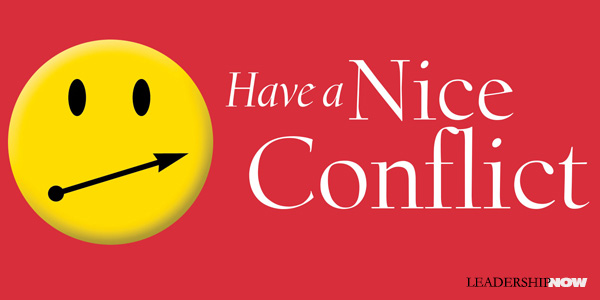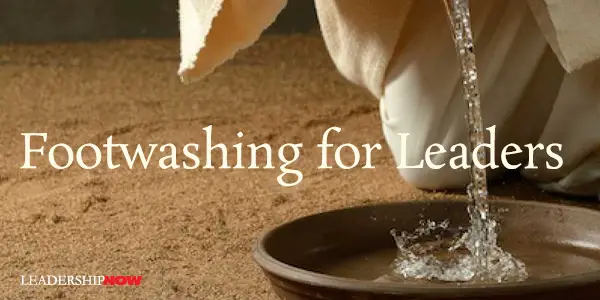 Leading Blog | Posts by Month |
 Leading Blog | Posts by Month |
07.31.11

LeadershipNow 140: July 2011 Compilation
Posted by Michael McKinney at 12:02 AM
07.28.11

Who's the King?
THE lion was completely convinced about his dominance of the animal kingdom. One day he wanted to check whether all the other animals knew he was the undisputed king of the jungle. He was so confident that he decided not to talk to the smaller creatures. Instead he went straight to the bear. “Who is the king of the jungle?” asked the lion. The bear replied, “Of course, no one else but you, sir.” The lion gave a great roar of approval. He continued his journey and met the tiger. “Who is the king of the jungle?” The tiger quickly responded, “All of us know that you are the king.” The lion gave another roar of pleasure.  This story illustrates that even in the face of another point of view, we reshape the feedback until it supports what we want it to mean. We often will do anything to maintain the status quo. The problem is that reality is slipping further and further away. “Some leaders are like the lion,” says Manfred Kets de Vries author of Reflections on Groups and Organizations. “Reality testing isn’t their forte. They are not good at making sense out of feedback. Instead, they create their own reality, wanting to see only what they like to see.” 
Posted by Michael McKinney at 04:19 PM
07.26.11

Have a Nice Conflict!
READING Have a Nice Conflict was like listening to my Dad again. He first met “Doc” Porter in the early seventies and they clicked almost immediately. Elias Porter’s Relationship Awareness Theory, on which the book is based, resonated with my Dad. Behaviors are the tools we choose and use to support our self-worth.Have a Nice Conflict is the story of sales manager John Doyle who has been passed over for what he believes is a well-deserved promotion. He has lost some of his top performers because he rubbed them the wrong way. When he turns up at an old friend and client’s office to explain yet another change in sales reps, he puts him on to Dr. Mac to help him improve his people skills at both work and home. Dr. Mac explains to John that there are many ways of interacting with others. We have default ways of behaving and when in conflict we often shift into other behaviors to maintain our self-worth. While we are trying to do the “right thing” to maintain our self-worth, conflict can happen when our “right thing” appears to be the “wrong thing” to another person. Conflict can be prevented by seeing contentious behavior as merely a different style instead of a direct challenge or threat aimed at annoying you or derailing you. He introduces him to the Strengths Deployment Inventory (SDI) which is a tool to help you understand the motivations behind your own behaviors and to better discern the motivations of others. By giving you a framework it helps you to understand what you and others are feeling and then helps you be better able to respond. Having a nice conflict is about taking personal responsibility for the interaction. To create movement toward resolution, we need to show the other person the path back to self-worth—where they feel good about themselves. That path may be different than yours. The concept should be taught in schools, however, the thought process is essential for leaders. The book alone offers valuable insights into the process and methodology, but coupled with the SDI you’ll have greater success. The authors offer a discount on the SDI to readers of the book. 
Posted by Michael McKinney at 05:08 PM
07.20.11

Information Overload and What You Can Do About ItKnowledge workers think for a living to varying extents, depending on the job and situation, but there is little time for thought and reflection in the course of a typical day. Instead, information—often in the form of e-mail messages, reports, news, Web sites, RSS feeds, blogs, wikis, instant messages, text messages, Twitter, and video conferencing walls—bombards and dulls our senses.Consider this: A 30-second interruption can result in as much as 5 minutes of recovery time. In total, interruptions plus recovery time consume as much as 28% of the knowledge worker’s day. The volume of information we have today “throttles productivity, reduces our capability to absorb and learn, puts our physical and mental health at risk, and interferes with personal and business relationships.” Jonathan Spira, CEO of Basex, a research firm focusing on issues companies face in the knowledge economy, explains in Overload! why we are in the state we are in and what steps we can begin to take to better manage it. Even as dry as information tends to be, this is an absorbing book. Spira claims that the changes in how we use and view information that will happen over the next 50 years will not only reshape the globe but turn it inside out. Today, information overload costs the U.S. economy a minimum of $900 billion per year in lowered employee productivity and reduced innovation. To manage successfully in the knowledge economy, we must recognize key differences in how knowledge workers work. Their tasks can be categorized into six overarching tasks: searching, creating content (sometimes re-creating), thought and reflection, sharing knowledge, and networking. Interestingly, a 2010 Basex study found that of these tasks, knowledge workers only spend only 5% of the day engaged in thought and reflection. The one task that is essential for all the rest we spend so little time performing. We must allow [require] workers more time for thought and reflection if they are to be more productive, efficient, and effective. Too much information without reflection can stall our productivity. It affects our ability to manage thoughts and ideas, contemplate and even to reason and think. We develop a state of what has been termed, continuous partial attention; to give only partial attention continuously. Science writer Steven Johnson described it this way: It usually involves skimming the surface of the incoming data, picking out the relevant details, and moving on to the next stream. You’re paying attention, but only partially. That lets you cast a wider net, but it also runs the risk of keeping you from really studying the fish.Researcher Linda Stone adds this: It is motivated by a desire to be a LIVE node on the network. Another way of saying this is that we want to connect and be connected. We want to effectively scan for opportunity and optimize for the best opportunities, activities, and contacts, in any given moment….It is an always on, anywhere, anytime, any place behavior that involves an artificial sense of constant crisis. We are always on high alert when we pay continuous partial attention. Although there are tens of thousands of things we could do says Spiria, he offers ten tips that, when observed, will help lower information overload for everyone:
Posted by Michael McKinney at 08:56 AM
07.18.11

5 Impediments to Turnaround and GrowthMark Fuast believes that we need to adopt an attitude of “growth regardless of current success.” In the very practical Growth or Bust, he asks, “How much untapped potential lies within your business?”In his experience as a growth and turnaround consultant, Faust has found that improving sales and profits has little to do with sales training, consulting, or other quick fixes. We already know what to do. “Fostering new growth is more about innovation than marketing angles, sales productivity, or skills; growth is more about a culture of continuous improvement than marketing blitz; growth is more about possibility-thinking than fear-fostering quotas.” Growth or Bust shows leaders how to create a growth revolution. And it starts at the top. The first person to turnaround is you. “There is no virtue in leadership as important to accelerated growth and turnaround as that of humility.” He lists five impediments to turnaround and growth that any leader should look at: 1. Pride. Unhealthy levels of pride contribute to a leader’s failure to give credit to others, an unwillingness to listen to others, an inability to share emotional ownership of ideas or company success, and prevent a leader from admitting that they may be a contributor to any problem. 2. Abusive Relationships. Inappropriate relationships an abusive behavior intended to demean or control others creates a ripple effect throughout the company. 3. Gossiping. Repeating any report that is not positive about others to those who have no responsibility in the matter is poison. Even when a bad report is 100% factual, it is still gossip. 4. Greed. Unfair pay and entitlement at the top often becomes obvious to the employees and growth is constrained as a result. 5. Any of the Five Dysfunctions in the Principle of Authority:
Posted by Michael McKinney at 07:14 AM
07.15.11

5 Leadership Lessons: What Went Wrong? Car Guys vs. Bean Counters Lutz devotes a chapter talking about GM’s failed “culture of excellence.” A misunderstood “drive for excellence” bore some really strange fruit says Lutz. In this culture, management had to improve on every detail, no matter how trivial, “focusing their ray guns of unbridled excellence on targets of complete irrelevance.” It was “grindingly negative, detail-focused, and customer-distant.” This is an easy pit to fall into in part due to the inward-focus described in point four below. Lutz described it as typical GM hubris: “if we’re doing it, we do it all the way. We know what’s best, no matter what others are doing.”
Posted by Michael McKinney at 01:43 PM
07.14.11

Leading Views: Alain de Botton on Success and Snobs Alain de Botton, author of The Pleasures and Sorrows of Work, shared his views at TED on success and snobs:
Alain de Botton, author of The Pleasures and Sorrows of Work, shared his views at TED on success and snobs:
One of the interesting things about success is that we think we know what it means. A lot of the time our ideas about what it would mean to live successfully are not our own. They’re sucked in from other people. And we also suck in messages from everything from the television to advertising to marketing, etcetera. These are hugely powerful forces that define what we want and how we view ourselves. What I want to argue for is not that we should give up on our ideas of success, but that we should make sure that they are our own. We should focus in on our ideas and make sure that we own them, that we’re truly the authors of our own ambitions. Because it’s bad enough not getting what you want, but it’s even worse to have an idea of what it is you want and find out at the end of the journey that it isn’t, in fact, what you wanted all along. One of the reasons we might be suffering is that we are surrounded by snobs. A snob is anybody who takes a small part of you and uses it to come to a complete vision of who you are. That is snobbery. And the dominant form of snobbery that exists today is job snobbery — you encounter it within minutes at a party when you get asked that famous, iconic question of the 21st century: “What do you do?” The opposite of a snob is your mother.
Posted by Michael McKinney at 02:41 PM
07.13.11

Who’s the Real Leader in Your Office? How often have you wondered who the real leader is in your office? Maybe you need to delegate a critical project, and you can’t afford to put your faith in someone who is not up to the job. Or maybe you work under several managers, and you want to make sure that you are building rapport with the one who counts. Or maybe you’d like to do some self-inventory in order to gauge how far you might rise after four or five additional years. All of these are good reasons for wondering how to accurately assess leadership potential. Unfortunately, most people have been taught to think about this issue in all the wrong ways. As a society, we rely on some rather misguided ideas about leadership success. As a result, when it comes to leadership selection decisions, we commit some pretty big errors. The first mistake stems from not knowing what qualities to seek in potential leaders. For decades we have been told that a charismatic personality, or Ivy-League training, or certain style, make all the difference. They don’t. None of these factors is a reliable predictor of leadership effectiveness. Other times we focus on qualities that do matter, but we don’t go far enough to seek a healthy balance. For example, we gravitate toward individuals who possess enormous passion and vision, but who lack solid character. Or we promote people with impressive courage, but who lack enough empathy to handle sticky social situations. The second big mistake we make when trying to judge leadership potential is the use of insufficient assessment techniques. In other words, even when we know what to look for, we don’t know how to look. We rely on backward looking interview questions, or inappropriate personality tests, or letters of reference from those who simply cannot predict how a person will perform in a fundamentally new position. Even the perennial favorite among promotion criteria – prior performance – is not a good indicator of future leadership success. At best, it tells only half the story. A solid manager with ten years of experience in sales, for example, might be poorly suited for a generalist role that will require her to lead an entire division. In our book Why Are We Bad at Picking Good Leaders? the two of us answer these crucial “what” and “how” questions. Based on more than fifteen years of experience working with premiere executive education programs and some of the best organizations in the world, we explain how to identify the very best leaders. Here are some highlights that will help you make your own determination: • Focus on the Qualities that Count. There are seven essential attributes of leadership success—integrity, empathy, emotional intelligence, vision, judgment, courage and passion. Take away just one, and a person who is called upon to lead will eventually fail. For example, former BP CEO Tony Hayward successfully climbed the corporate ladder for more than 25 years. But when the Deepwater Horizon exploded in 2010, his leadership faced a stiff challenge. In particular, he needed a strong sense of empathy to deal with an outraged public and a diverse set of competing constituents. Unfortunately, he was not up to the task. During an early interview, he claimed that the oil spill was “relatively tiny” compared with the “very big ocean,” and he consistently underestimated the extent of the leak. Obviously the spill wasn’t tiny from the vantage point of the Gulf Coast fishermen who lived nearby. Worse was the comment Hayward posted on Facebook to the effect that more than anyone else, he wanted the crisis to be over because, he said, “I want my life back.” This quip was widely seen as insensitive to the men whose lives had been lost in the explosion. President Obama responded, “He wouldn’t be working for me after any of those statements,” and although his days were probably already numbered, that was the last straw. Hayward lacked the kind of empathy that leaders need to survive. • Use the Right Assessment Techniques. Not too long ago, we met with a Fortune 500 president who was reeling from a poor hiring decision. Just six months after filling a key position, the company had to terminate its new hire and start a search all over again. When we asked the president how he and his team chose the person who was originally selected, he said: “He [the candidate who was hired] had great experience in the industry, a track record of turning around underperforming business, and already had relationships with several of our largest customers.” In addition, the company hired a search firm that conducted extensive background referencing, and all signs were positive. The candidate was results-oriented, friendly, well liked, and driven. While these findings sounded good, further investigation on our part revealed that the president fell into some classic assessment traps. The most serious mistake he made was relying on an evaluation process that was essentially backward looking. The president spent large amounts of time going over the candidate’s résumé and credentials: he asked about prior successes and failures, he asked others how the candidate performed, and so on. But this backward-looking investigation has limited predictive value when trying to determine a candidate’s likely success in a fundamentally new position. In our assessment practice, we overcome this obstacle by using a variety of different techniques, including simulations and case studies, direct observation in group settings, and specially created hypothetical scenarios that test a candidate’s leadership potential. This last technique is critical because it is forward looking. Unlike a typical interview question that asks candidates to discuss what happened in the past, these hypothetical situations present candidates with unfamiliar and challenging leadership situations. No amount of preparation or interview savvy will enable a candidate to fudge her answer or game the interview process. For more information on how the best companies in the world find first-rate leaders, including how to order Why Are We Bad at Picking Good Leaders? visit PickingBetterLeaders.com or email the authors directly at jcohn@liag-advisors.com and jmoran@liag-advisors.com.
Posted by Michael McKinney at 05:48 PM
07.12.11

Learn From Your Heroes, but Believe in YourselfIt is natural to want to be like the people we look up to. We want to recreate the success they have enjoyed in our own lives. So we try to imitate them. It seems like the shortest distance between two points. Of course, we are trying to copy a result. What we often fail to see is the work it took to get them to the place where they could do what they do. And sometimes it’s all flash and no substance.And while you can try to copy a style, mannerisms, or life path, what makes it work for them isn’t what is written down. It’s what they can’t teach you that makes it work for them. It’s the things you can’t easily articulate that come from the core of your being—that which makes you you—that makes the difference. Harvard Business School Professor and former Medtronic CEO Bill George, wrote, “Any prospective leader who buys into the necessity of attempting to emulate all the characteristics of a leader is doomed to failure.” It’s one thing to learn from others, it’s quite another to try to imitate them. A big part of the problem is the lack of confidence we have in ourselves. Sometimes in watching the success of others, we lose faith in ourselves. “There is but one cause of failure and that is a man’s lack of faith in his true self,” observed William James. Jazz saxophonist Stan Getz took a teaching position at Stanford in 1986. In an interview with a reporter about his role there, he put it this way: I’m a strong opponent of imitation. I always tell them that they have to be themselves. That’s hard, because they don’t believe in themselves, they believe in their heroes. And I will tell them: that’s perfectly alright, but your hero is the only one who can play that way. If you want to try and do the same thing, it will only be an imitation, however perfectly you will do it. I keep on trying to convince them that they have to play what they feel themselves. But that’s not easy.Your hero is the only one that can play it that way. Be yourself.
Posted by Michael McKinney at 04:43 PM
07.05.11

Footwashing for Leaders
AN EASY TRAP trap for any leader to fall into is the “Look what I did!” trap. Success easily erodes humility. Humility isn’t about the lack of ambition but acknowledging the luck, the good fortune, and the contributions of others to your success. It is the humility that comes with a habit of respect for others. Stephen Hall calls it the “gift of perspective.” It is indeed. Humility is all about perspective. Fast Company co-founder Bill Taylor argues in Are You “Humbitious” Enough to Lead? in the Summer 2011 Leader to Leader journal, that “the best way to deliver on an ambitious agenda for your organization is to embrace a sense of “humbition” in your personal style and as part of your leadership repertoire.” Taylor reports that “in a manifesto of sorts that urged up-and-coming IBMers to embrace a new leadership mind-set, Jane Harper, a 30-year veteran of IBM and a group of her colleagues offered a compelling description of what it takes to succeed in a complex, fast-moving, hard-to-figure-out world. Their strongly worded advice to aspiring leaders inside IBM should be read as words of wisdom for leaders at every level of all kinds of organizations:” “Humbition is one part humility and one part ambition. We notice that by far the lion’s share of world-changing luminaries are humble people. They focus on the work, not themselves. They seek success—they are ambitious—but they are humbled when it arrives. They know that much of that success was luck, timing, and a thousand factors out of their personal control. They feel lucky, not all-powerful. Oddly, the ones operating under a delusion that they are all-powerful are the ones who have yet to reach their potential. . . . [So] be ambitious. Be a leader. But do not belittle others in your pursuit of your ambitions. Raise them up instead. The biggest leader is the one washing the feet of the others.Success most often doesn’t come from our efforts alone but in our ability to include and organize the contributions of others; to coax the fragments of a good idea from the hearts and minds of others; from a practiced watchfulness that comes from knowing that a good idea can come from anyone or anywhere. The result, when it comes together—the execution of a great idea—should be humbling to any leader. It is humility coupled with ambition that correlates with results.  
Posted by Michael McKinney at 11:04 PM
07.01.11

First Look: Leadership Books for July 2011Here's a look at some of the best leadership books to be released in July.




For bulk orders call 1-800-423-8273  Build your leadership library with these specials on over 120 titles. All titles are at least 40% off the list price and are available only in limited quantities. “Today a reader, tomorrow a leader.” — W. Fusselman
Posted by Michael McKinney at 09:54 AM
|
BUILD YOUR KNOWLEDGE


How to Do Your Start-Up Right STRAIGHT TALK FOR START-UPS 
Grow Your Leadership Skills NEW AND UPCOMING LEADERSHIP BOOKS 
Leadership Minute BITE-SIZE CONCEPTS YOU CAN CHEW ON 
Classic Leadership Books BOOKS TO READ BEFORE YOU LEAD |
|